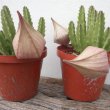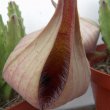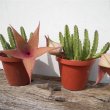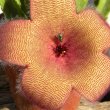| Botanical Name |
|
| Family |
Apocynaceae - The Oleander or Dogbane family. |
| Pronunciation |
sta-PEL-ee-uh gran-dih-FLOR-uh |
| Common Name(s) |
Afrikaans: aasblom; Makghaap; Slangghaap
|
| Plant Group |
- Ground Cover A plant with a low-growing, spreading habit, grown specifically to cover the ground.
- Perennial A plant whose life cycle lasts for three or more seasons.
- Succulent A plant having fleshy stems or leaves often adapted to dry conditions.
|
| Plant Size |
- Small to Medium
| Tree | 8m to 15m |
| Shrub | 75cm to 1m |
| Perennial/ground cover | 20cm to 40cm |
| Bulb | 30cm to 40cm |
| Succulent | 20cm to 40cm |
- Small
| Tree | 4m to 8m |
| Shrub | 50cm to 75cm |
| Perennial/ground cover | 10cm to 20cm |
| Bulb | 20cm to 30cm |
| Succulent | 10cm to 20cm |
|
| Position |
- Light or Dappled Shade Found below trees with sparse, open foliage. Ideal for the protection of herbaceous plants.
- Partial Shade The area is in shade for part of the day and in full sun for part of the day.
- Sun The area is in full sun for all or most of the day, all year round.
|
| General Information |
- Drought Tolerance: High The plant is well adapted to arid conditions; it can survive long periods of drought and high temperatures without extra water.
- Evergreen Plants that have leaves all year round.
- Frost: Tender A plant that will not survive any frost or low winter temperatures.
- Water Wise Plant species originating from low rainfall regions that require less water to survive and thrive than other plant species.
|
| Specific Information |
Stems of Stapelia grandiflora usually reach a height of 200 mm. Flowers are up to 150 mm in diameter, varying from dark purple-brown to biscuit brown, covered with purple hairs. The flowers have an odour of rotting meat and the hairs, colouring and surface of the flower mimic decaying animal matter most successfully. Flies, the main pollinators, are often deceived, and lay their eggs around the center, fully believing that it will be a source of food for their hatching young.
|
| Ad Break |
|
| Flowers |
| Description |
|
| Season |
- Summer Plants will seldom bloom for the entire season as given in the list, but should flower during a period within these parameters.
|
| Colour |
|
| Growth Rate |
- Moderate Specifying growth rate can be very misleading as there is considerable variation of growth rate depending on type and species of plant, available water, supplementary feeding, mulching and general care, as well as the plants suitability and adaptability to the garden environment.
|
| Plant Uses |
- Container Trees, shrubs and ornamental species that can adapt to growing in a restricted environment.
- Ground Cover Low-lying plants that spread fast, require minimal maintenance, and cover large expanses or bare areas between bulbs or shrubs. They provide protection from erosion and drought and improve the visual appearance of the garden.
- Pot Plant A plant that needs a protected environment on a patio or indoors.
- Rock Garden An area constructed of larger rocks, arranged naturally, to emphasise the use of stones as a main element. Generally plants used do not need a lot of care.
- Stabilize Banks Plant is used to prevent soil erosion because their roots will form a mat that stabilizes the soil and keeps it from washing away in heavy rains.
- Wild Garden An indigenous garden planted for the benefit of wildlife and birds. Provides food, water, a variety of mini-biomes and no poisonous chemicals are used.
|
| Distribution and Habitat |
scattered sparsely from the Great Karoo to the Free State and southwards to Port Elizabeth, occurring mainly in the Eastern Cape, often in the shade of shrubs
|
| Planting Suggestions |
Stapelias require a well-drained, sandy soil. For potting use equal parts of washed river sand, potting soil and topsoil. Do not over water. Place in a warm, sunny position. They need a rest period during winter without water. Stapelias are prone to stem rot: immediately evidence of rot is discovered, the affected parts should be cut away and destroyed. Allow the cut sections to dry for two weeks before laying them on the soil to re-root.
|
| Medicinal Uses |
The Zulus reportedly use parts of this plant as a remedy for hysteria.
|
| Ad Break |
|











Comments
Flower will dry before opening up
Hello, i am very pleased with the stapelias I have! I have 4 different kinds which grow extremely well. All the care you talk about i don't really give them. They grow easily here in Peru. Butttt! I have 1, for some months now, that grows very well, makes lots of flowerbuttons but all of them dry up looks like just before opening up :( . Do you have any clue what I might be doing wrong? Regards Monique
Stapelia flower buds that drop off before opening
Hi Monique
The only reason a plant produces flowers, is to produce seed. If external circumstances are suspect, the buds will be dropped so that the resources within the plant are not wasted.
Although Stapelias are tough and resilient, they are sensitive to climatic changes and will drop their buds if conditions are not conducive for setting seed.
I found no single, definite cause for this occurrence. The main reasons that have been cited are as follows:
The plant is moved to a different position during the budding period.
Moving the plant to a different environment or position alters the mini-habitat to which the plant has become accustomed and the energy needed in adjusting to this artificial climate change results in the buds being dropped.
The plant may have been too dry sometime during the budding period.
Too little moisture would suggest that the plant will not have the resources to promote successful seed production.
The plant may have been too wet sometime during the budding period.
Too much moisture would suggest that the weather may be too wet for successful pollination to take place.
Sorry I am unable to be more specific. Perhaps another reader will be able to shed more light on this topic.
Kind regards
Lorraine
Discuss this plant
Share knowledge, ask a question or give an experience.